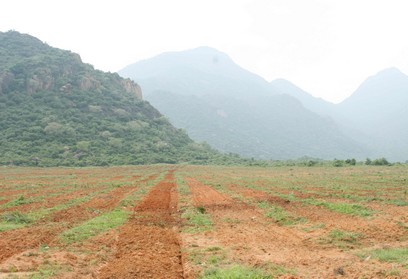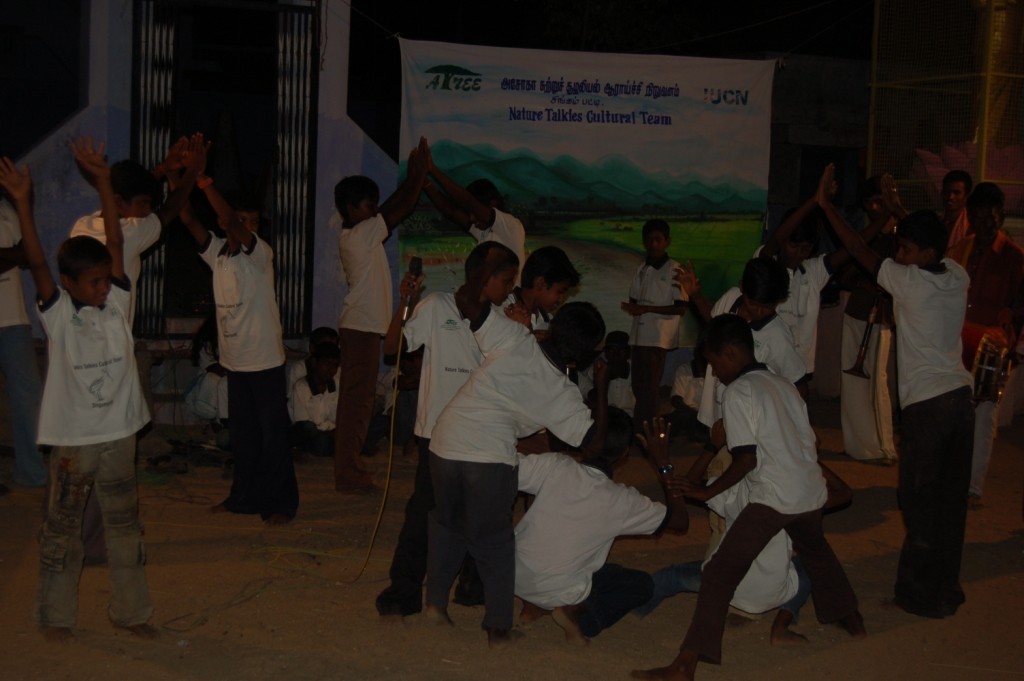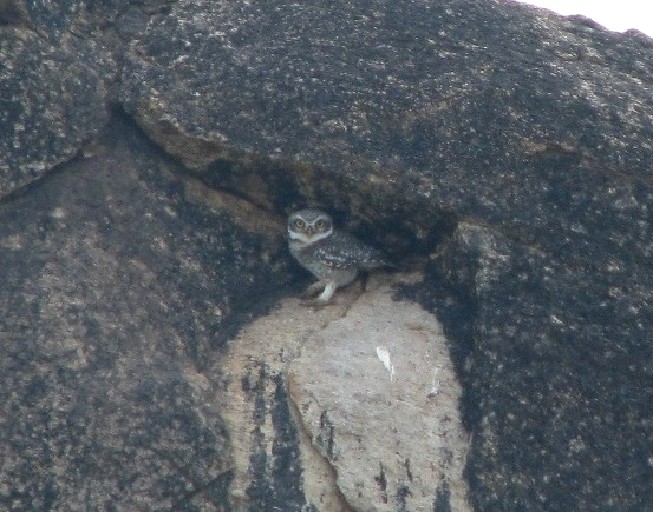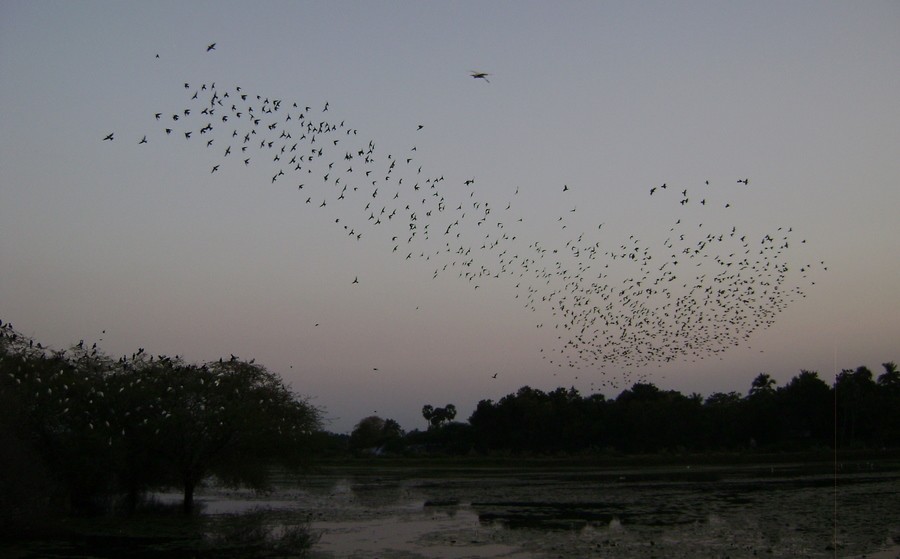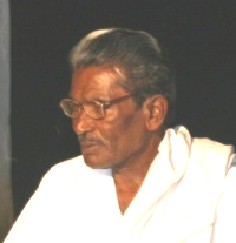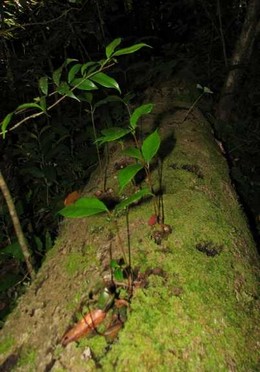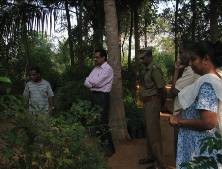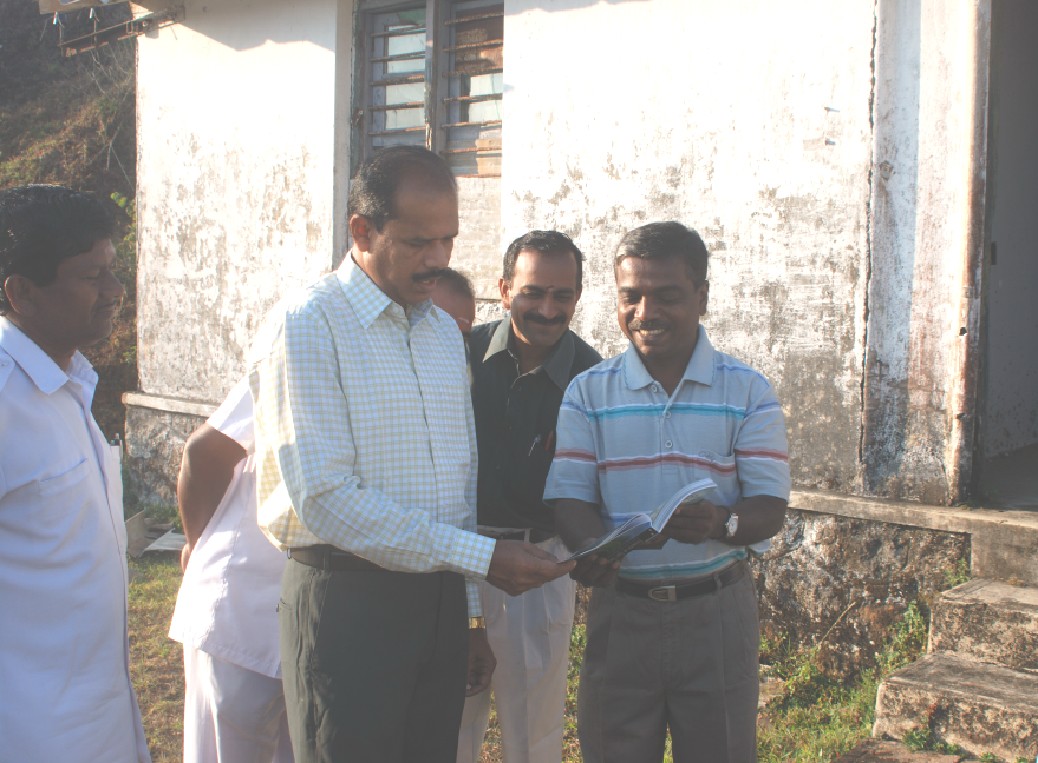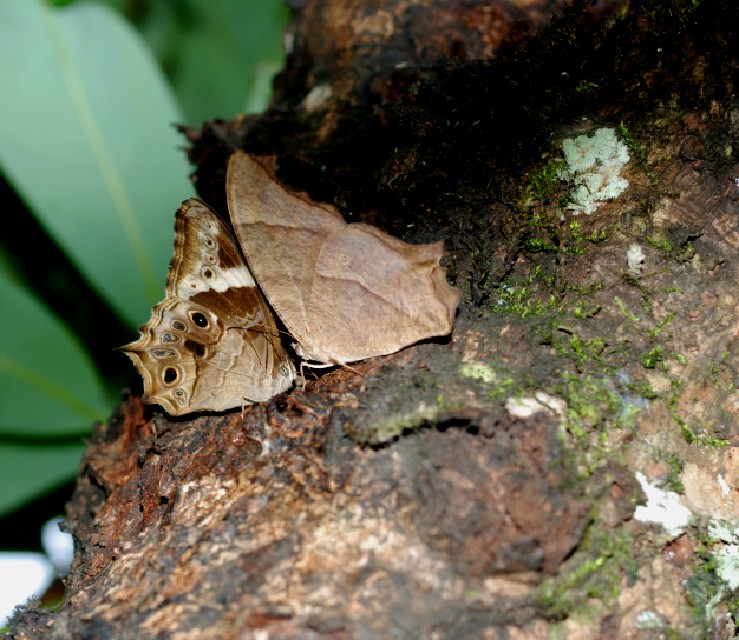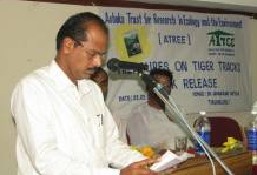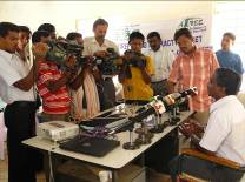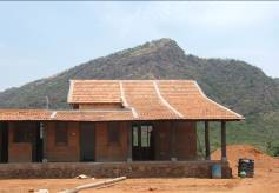Agasthya
A newsletter on the Natural History, Ecology
and Conservation of the Agasthyamalai region, Western Ghats, India.
World Environment day debut for ‘Nature Talkies Cultural Team’
ATREE’s Agasthyamalai Community–based Conservation Centre (ACCC) is working with rural children to improve their knowledge of ecology and environment. Being part of our conservation education (CE) programme, the kids have learnt local folklore art such as kaliyal, paraiattam, oyilattam and dramas. A cultural team called ‘Nature talkies’ was formed with 13 school going students from the Singampatti villages. Their first performance was planned in the Padmaneri village located in the southern part of KMTR that harbours a bat colony comprising of thousands of individuals in Banyan trees along the road A tank called Padmaneri periakulam close by has several water birds. Our programme highlighted the conservation of these bats and birds .
On the special occasion of World Environment day, our team travelled to Padmaneri. It was a pleasant evening and the enthusiastic young artists started performing on the van itself with a game of ‘Paatuku paatu’ with Allwin and Merlin. The president of the village panchayat warmly welcomed us and the village kids were excited to see our team. The Nature talkies team debut performance was thoroughly enjoyed by the villagers and the kids won their hearts. The Kaliyalattam, Oyillattam made the villagers dance and they also sang along with vocalists Merlin and Ambai Shanmugam. The characters of the monkey, hare, deer and tiger came alive during the performance. The programme concluded with the distribution of books from ATREE by Mr. Sivasailam, Head Master of Theerthapathi Hr., Sec., School and Mr. Vishwanathan, Director of Thamiraparani Trust for Environment and Education.
M. Mathivanan
An elephantine problem
Human-wildlife conflicts are almost a daily occurrence as agriculture and urbanisation move closer and closer to natural habitats. We cultivate extensively next to the forests and animals naturally come out of forests and feed on crops, cattle or dogs; if food is not the case we curtail their annual migratory routes by building resorts or homes in them. The issue of elephants seen close to the road from Cheranmadevi to Kalakad which was in local papers for some time is due to the latter. It has always been customary for the elephants to come from the hills during winter, spend some time in the scrub forests and move up again when it becomes dry. The Cheranmadevi scrub was the last remaining of them but it now stands converted to a barren land fenced by electric wires (pic). With the scrub gone where would these animals go? It’s an issue of ‘customary rights’ of animals but who is bothered when even human customary rights are violated. Ironically, the panchayat presidents from the area seemed divided in this issue. The ones from villages close to the forest condemned the clearing of the bushes and confirmed that elephants are annual visitors and do no great harm while the ones farther away were paranoid on seeing the elephants and wanted them driven off. They also later accepted that the scrub acted as a wall and kept these ‘scary’ out of sight. We hope the newly formed buffer committee for KMTR and the proposed KMTR tiger foundation will just not deliberate on these issues but do something constructive to stop the denudation of KMTR buffer.
The KMTR nature guide ‘Treasures on Tiger tracks’ launch at Tirunelveli was attended by several important dignitaries and other invitees. We thank them all for coming and supporting our activities in the region and hope we can all continue our good work to conserve the natural resources of Tirunelveli district.
T.Ganesh
The big role of small mammals in forest dynamics
Often, one may think that it is perfectly safe and harmless to collect dead and fallen wood from the forest and use it. But little thought is given to validate the above statement. Such fallen trees often pull down several neighboring trees with them and open up the forest. In spite of this loss, they create important tree fall gaps which provide a favorable environment for ‘pioneer’ species. The lesser known small mammals like the palm civets have a very unique habit of walking on the roots, branches, lianas and fallen trees. On the ground, they seem to be more comfortable moving about on these roots of trees or fallen logs than on plain ground. In the process, they also drop their scat on the logs and roots. Being mainly fruit eaters, they have a substantial quantity of undigested seeds in their scat - this tell-tale sign is also a key to identify their diet and also to see how far they have moved the seeds from the closest tree of that species.
One such seemingly silly behavior of walking on roots and logs, if seen in the larger context of forest regeneration makes sense. They act as efficient seed dispersers. By taking the fruit pulp as reward, they disperse the seeds on places like fallen and rotting logs where the scope for germination is higher than the litter laden soil. With such seeds embedded in organic nutrient-rich rotting logs, the seeds mature to saplings before settling into the soil to become trees. With the economic importance of dead wood increasing, it is also imperative to recognize and understand the importance of this ‘wood’ in the woods rather than in the stove. Though the whole process is definitely not as simple as it seems, it is nevertheless important for forest dynamics.
Season for picnickers and poly bags
The hot days of April have given way to the windy ‘saaral’ or Courtalam season. The south-west monsoon winds have started to blow over the Agasthyamalai peaks, bringing along with it some picturesque clouds that drape the hills like snow over the Himalayan peaks. The interplay of light and clouds create fleetingly stunning displays that are sometimes hard to capture on film but will remain etched in ones memories.
It’s one time that should not be missed by people who delight in photographing or painting monsoon clouds and landscapes. The saaral carried by strong winds envelops the valleys especially of Tamiraparani and Manimuthar. This gives an impression of mist from a distance and creates in one a longing to be there away from the 40 deg heat of the plains.
No wonder people flock in large numbers to the cascades or Paallis (locals’ pronunciation for falls) coming out of ‘Paallis malai’. There are also bathing and dam tours conducted for people to have a dip in various Paallis over a week. All this influx pollutes the waters and the problem of poly waste management is common. Can something be done? Maybe the cab drivers can tell his clients to bring back the poly wastes to the car to be disposed outside the forest. But individually let’s all strive to keep the waters as beautiful as the clouds and mountains from where they come.
Bleeding trees, feasting butterflies and fighting staghorns
After a weary day in the forest canopy back in 1990, our team hit the road hoping that the Upper Kodayar bus would shuttle us back to the field station. That was not to be, as the bus broke down. Lugging our back packs, we started trotting to Upper Kodayar and after a break in Nalmuku, for a tea refill, we continued along the road cutting through the tea bushes. As we descended the 11th kaadu slope, to enter into the forest, in the evening light we saw something flying in and out from the trunk of the Persea macrantha tree. We approached the tree, and witnessed something which was the high point of our day. There were 25 odd butterflies, bustling on an old wound of the tree that had a thin layer of ooze on it. Apart from the gregarious common evening browns, we recorded Southern Duffer, Oakleaf, Tree browns, Greater and Dark Evening Browns which were not easily encountered on transect walks. Some of these unusual resources are patchy and far apart yet well tracked by these animals. On a closer look at the trunk, we saw a small-sized female stag horn beetles with tiny horns and two to three pairs of male stag horn beetle with their long horns locked, pushing each other not allowing access to the female beetle. Now the butterflies presence on the tree was easy to discern; they were found probing on the wound. But, why did stag horns choose this spot to stage the fight? Were males preventing each other from accessing the ooze which is a precursor to sex pheromone? Or were they staging the whole drama of `who is mightier’ to access the female on a resource patch? From then on ‘Persea spot’ was a popular stop en route to field work until the tree got knocked down. So we could never solve the mystery of Persea ooze. We did inflict some damage to other Persea trees, hoping to have replay of the drama, utmost we had few brown butterflies come to the ooze. We realised that it is the domain of a chemical ecologist, to bring back the scene.
- M. Soubadra Devy
It was much more than counting birds
As an amateur birder, when I joined Abhisheka for a water bird survey in Tirunelveli, it was an experience filled with unforgettable moments. Be it admiring the beauty of the Western Ghats, or traversing numerous cross-country routes leading to some hidden gems of lakes or counting birds till your eyes squint or the soul satisfying simple village meals, everything was a lifetime experience. Among the many beautiful moments, two stand out in my memory. We had walked along a big lake through fairly rocky terrain in extreme heat. We climbed behind some huge rocks and sat down in the shade. Suddenly we realized that a cute Spotted owlet was looking at us from his hideout about an arm’s length away, we felt a great sense of kinship. The second was seeing a Common kestrel amidst a landscape which was falling prey to mining. I can never forget the sense of helplessness, with which we watched that Kestrel and the Waders braving the dust from the excavators!
I got to know village life, the issues concerning not just the environment but also the intricacies of the local socio-political realities and the logistic difficulties like arranging a punctual driver that a researcher has to deal with. It all gave me a glimpse of the “normal” routine of the dedicated ATREE team.
Stunning displays of 'cloud-painted' skies.
Photo: T.Ganesh
.
A treat for Canopy Art contest winners
ATREE had just the perfect award in store for the artists who won the art contest in the 5th International Canopy conference, 2009. It was a trip to KMTR (Kallakad Mundunturai Tiger Reserve). Having heard much about the Agasthyamalai hills, Cullenia flowers and its rich biodiverse habitat, it had been on my ‘must-visit’ list for long. However, this became a reality in February 2010. Manju Das and I, reached on 25th morning and were based at the Singampatti field station. We were accompanied by Abhisheka, who works as a research associate with ATREE. Spread over 3 days, we visited wetlands, heronries, bat roost, dry-deciduos and evergreen habitats, which added up to about 120 species of birds.
One of the highlight of the trip for us was the incredible aerial display of a flock of about thousand or more Rosy Starlings against the setting sun at the Vaagaikulam heronry. It was a performance… a spectacle to behold! They almost formed a big dark cloud above our head. As the evening light faded across the horizon, continuous batches of birds- Egrets, Herons, Cormorants and Ibises kept pouring in, to settle down on the narrow stretch of Acacia trees, amidst the large water-body, just a few meters from where we stood. We stayed on till dark and soon the trees looked like they were illuminated with lights because of the hundreds of Egrets.
My sincere thanks to ATREE and the KMTR team for planning such a wonderful trip for us. And a special thanks to Abhisheka, who was there with us throughout, showing and telling us everything about KMTR.
-Sangeetha Kadur
ASHOKA TRUST FOR RESEARCH IN ECOLOGY AND THE ENVIRONMENT
Centre for Excellence in Conservation Science
Royal Enclave,Srirampura,Jakkur Post
Bangalore-560064
Telephone: 080-23635555 (EPABX)
Fax : 080- 23530070
Any and all opinions expressed in this newsletter are solely those of the author(s) and do not reflect the opinion of ATREE.
Editorial Team
Editor: T. Ganesh
Associate editor: Vivek Ramachandran
Editorial Review: R. Ganesan, M. Soubadra Devy
Design and presentation:(print) Jahnavi Pai
(web) Vivek Ramachandran
Nature Talkies in action.
Photo- Allwin Jesudasan
A S H O K A T R U S T F O R R E S E A R C H I N E C O L O G Y A N D T H E E N V I R O N M E N T
Cloud of Rosy Starlings at dusk
Photo: Manju Das
Scrub around KMTR converted to a barren patch of land
Photo: T Ganesh
Plants regenerating on dead wood.
Photo: K. S. Seshadri
Threat-end Sloth bear
If we would attempt to estimate the number of times we encounter the word “threatened” during office hours, I’m sure it will be a sizeable number. On the other hand, I’ve lived through a short five seconds of “threatening” charge by two sloth bears which are not really a threatened but vulnerable species! Barely a hundred meters away from the Chinna Manjoli camp, while I was walking towards a few camera- traps, the sloths and I walked into a common junction on the trail! The sloths uttered a “threatening” grunt, which sent me into “life-threatening” mood and I instinctively uttered a “life-saving-yell”. It can be best verbalized as an “exponentially raising aaaaaaahhhhhhhhh, that dipped to silence for a nanosecond, and once again rose to an “aaaaahhhh”!! I do not know whether the resulting pattern was “sinusoidal”, but was certainly “simultaneous” in terms of locomotion! My limbs started moving immediately and I managed to run back to the camp in a jiffy to meet my colleagues!
Far away from this location, while in lowland Singampatty, my colleagues and I met two more sloths once again last week. They were seen scurrying for cover from the jeep headlights twenty feet away; everybody had a grin on their face. I too managed it but “simultaneously” latched on to the wind screen handle and shut the window!
A ticking bomb: Human wildlife conflict in KMTR
Our study on attitudes of people along the eastern boundary of KMTR inspired us to work on the human wildlife conflict in the region. We are now conducting a preliminary survey using focus group interviews to know the extent of the problem. Our focus was on crop raids, but it appears that the problem is not just confined to that. Out of the twenty four villages sampled so far, two villages have reported human casualties caused by pigs, two others caused by bear. A few more villages have reported physical injury while one village reports frequent cattle lifting by leopards. In our earlier interviews, we have met respondents who would spend entire nights in their fields to chase away pigs and sambar. All villages sampled within a 3 km radius from the boundary report an increase in conflicts over the years.
The main reason for the increase, they cite, is the increased strictness by the forest department. The raiding animals are not killed like before because of fear of the forest department. Hunting parties that used to go for pigs and sambar are rarer than before. In the region near Gadana, it is believed that wild pigs and sambar hide in private farmlands in the morning and raid crops in the night. Electric fences installed along the forest boundary in a few villages are not very effective because of maintenance issues. Langurs and macaques are considered a nuisance here, damaging property. The increasing video coverage in popular TV channels of crop raiding elephants is bad advertisement for the forests of KMTR. With people becoming less tolerant towards wildlife, effective measures need to be taken to mitigate the complex human wildlife conflict in this region.
Bamboo brown and Common evening brown feeding on Persea macarantha ooze.
Photo: R.Ganesan
Will their promises get transformed to actions?
A field visit to Koondankulam Bird sanctuary was organised for the stakeholder representatives of selected villages on 6.7.2010. The stakeholder representatives enjoyed a short bird watching session at the site. Later a presentation cum discussion on ATREE’s work in KMTR and the process of selecting the wetlands for conservation was given to the participants. The progress on the conservation plan for Vagaikulam tank was also appraised to the participants. Two protected area guardians spoke about the importance of birds to humans. The stakeholder representatives who were mostly panchayat presidents gave their suggestions for the conservation of wetlands and the problems inherent in it. They were more than willing to co-operate with ATREE in acquiring protected status for the wetlands and were also willing to help ATREE in drawing up a conservation plan for the selected wetlands. It would only be fitting if the concerned government authorities and politicians take up the matter seriously and give them full support to transform such discussions at the ground level into workable models.














